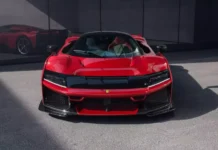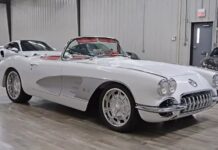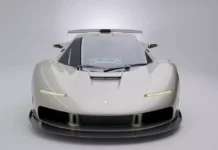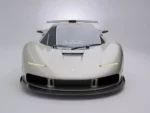The BMW 3 Series is the most iconic product of BMW and has gone through 6 generations.
In the mid-size segment, the 3 Series is the unrivaled leader of sport sedans and has maintained its dominance for many years. Since its introduction to the market in 1975, over 12 million 3 Series have been delivered to customers worldwide. With its exceptional engine performance, precise power steering system, and unmatched agility, the 3 Series continues to attract an increasing number of customers.
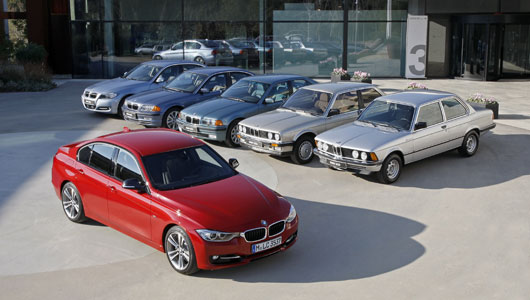
1975 – 1981: First generation
In July 1975, BMW introduced the first generation of the 3 Series, marking a new chapter in the history of the modern automotive industry. Sporting a 2-door sedan design that combined compact dimensions with sporty aesthetics, the 3 Series featured distinctive kidney-shaped grilles and a MacPherson suspension system. With dimensions of 4,355mm in length, 1,610mm in width, and 1,380mm in height, the BMW 3 Series surpassed its contemporaries.
The first-generation BMW 3 Series included models such as the 316, 318, 320, and 320i, all equipped with 4-cylinder engines ranging from 1573 to 1990 cc in displacement. All models ran on conventional gasoline.
A distinctive feature of the first-generation 3 Series was its driver-focused cockpit design, a characteristic that BMW has upheld for many years.
In just 6 years since its introduction, the first generation BMW 3 Series reached the remarkable milestone of one million units produced, solidifying its position as the most successful BMW model.
1982 – 1990: Second generation
The second generation BMW 3 Series inherited the strengths of its predecessor and brought advancements in all aspects, leading to sales of 2.3 million units worldwide.
The second generation BMW 3 Series offered a wide range of versions, including two-door and four-door models, 4 or 6-cylinder engines, rear-wheel or all-wheel drive, sedan or wagon body styles, and even a convertible. The initial 4-cylinder models came with either a 5-speed manual transmission or an optional 3-speed automatic transmission, while the 325/325e/325i and 318is models featured a powerful 4-speed automatic transmission. The wagon version gained popularity compared to the rare all-wheel drive 325ix version. Additionally, in 1988, BMW introduced the legendary M3. However, the M3 was mainly produced for collection purposes and carried a hefty price tag at the time.
The 4-cylinder models were divided into two main types: the 318i, produced from 1984-1985, featured the M10 8-valve engine with 101 horsepower, and the 318is, equipped with the M42 16-valve engine with 134 horsepower. While the earlier models did not fully showcase the characteristics of these engines, the later models were particularly impressive. The 318is stood out as a prime example of superior performance at a high price point.
The 6-cylinder models were popular and offered superior features compared to their 4-cylinder counterparts. This range included the 325i and 325/325e models, powered by the BMW M20 6-cylinder engine renowned for its smoothness. The 325i, with its 2.5-liter engine producing 167 horsepower and 164lb-ft of torque, showcased BMW’s traditional free-revving nature. On the other hand, the 325/325e featured the eta 2.7-liter engine with 121 horsepower, tuned for enhanced fuel efficiency.
Despite the passing of years, the second generation 3 Series retained its agile driving capabilities and perfect balance, providing a composed driving experience even when corners and challenging roads were involved.
1990 – 1998: Third generation
In 1990, the third generation 4-door BMW 3 Series was introduced, featuring significant improvements in design, technology, size, and interior space. The 2-door version followed in 1992, displaying a sleek coupe styling. Just a few months later, consumers had the opportunity to experience the convertible and M3 versions. In 1994, BMW engineers successfully brought the concept of the 3 Series Compact to life, combining comfort with sporty driving performance.
The third generation continued the success of its predecessors in the market, paving the way for the 3 Series’ dominance in subsequent years.
1998: Fourth generation
The fourth generation BMW 3 Series made its debut in 1998, boasting improvements in power, comfort, and safety compared to its predecessor.
Widely acclaimed across all markets, the fourth generation 3 Series became a benchmark for the BMW brand. In 2002, a record-breaking 561,249 units were sold, making it the most successful 3 Series generation.
2005: Fifth generation
The fifth generation of the 3 Series was unveiled at the 2005 Geneva Motor Show. It quickly gained recognition and accolades from the industry for its powerful engines, smooth driving dynamics, captivating design, and advanced technology. The current BMW Efficient Dynamics development strategy epitomizes the comfort provided by a BMW 3 Series, offering low emissions and fuel consumption.
All 2010 models were equipped with direct fuel injection using BMW’s High Precision Injection system, meeting the EU5 emission standard. Notably, the BMW 320d EfficientDynamics Edition became the most fuel-efficient model in the mid-size sedan segment.
2011: Sixth generation
Visually aligned with the 5 Series and 7 Series, the new BMW 3 Series, introduced as the 2012 model, demonstrated its larger and more muscular stance. With a width increased by about 50mm and a length extended by about 90mm, the new 3 Series exudes a more commanding presence. Despite the greater dimensions, the new BMW 3 Series maintains a perfect 50/50 weight distribution and is 40kg lighter than its predecessor.
Perhaps the most notable change in the BMW 3 Series is found beneath the hood – the 2012 (2013 in some markets) BMW 328i is powered by a 2.0L TwinPower turbocharged 4-cylinder engine, delivering 240 horsepower and 260 lb-ft of torque. This allows the 328i to accelerate from 0-100km/h in just 5.7 seconds.
Meanwhile, the 335i utilizes a 3.0L turbocharged 6-cylinder engine, producing 300 horsepower and 300 lb-ft of torque, with 0-100km/h acceleration achieved in a mere 5.4 seconds.
Conclusion
Over the span of 36 years, the BMW 3 Series has consistently led the mid-size sports car segment, captivating customers with its exceptional driving performance and relentless innovation. With its continued commitment to excellence, the 3 Series is set to further conquer the hearts of customers worldwide. The sales record is certain to surpass the milestone of 13 million units.
In the Vietnamese market, BMW Euro Auto selected the 328i model for its introduction on March 29, pleasing customers with its impressive features.
>> 3 Series 2012 – BMW Euro Auto’s Expectations
Hoang Tuan (source: PLXH/compiled)




